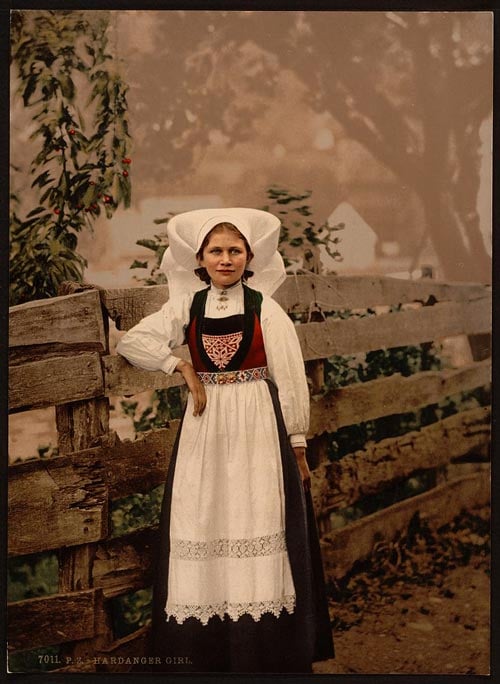Bunads are garments worn for Norwegian celebrations and holidays such as weddings, baptisms, graduation, confirmation and May 17th, Constitution Day. Many perceive these folk costumes as following a rigid set of standards based on ancient tradition, when in fact, bunads as they are today have only been around for 100 to 150 years.

A Hardanger girl, Hardanger Fjord, Norway. Source: www.loc.gov
Origins
Some of these garments emerged from the Norway’s romantic nationalism movement of the late 1800s. In the case of several bunads, writer Hulda Garborg and folklorist Klara Semb were driving forces, traveling around the countryside, encouraging makers to plumb the history of their region’s textiles and costume traditions to create designs.
Other bunads were constructed by committee, backed by painstaking research and clothing scraps sourced from museums, archives and the attics of great-grandmothers. Very few of these costumes predated the national romantic movement. Most of them came after 1900 and even after 1960. So, while the bunads give a nod to Norway’s past, some of the traditions are decades, rather than centuries, old.
Creators and Makers
The creators of women’s bunads were almost always women, who spent hours, months and years of their lives to create a garment that best represented their region, their forbears and the sewers who poured their ingenuity and skills into this wearable art. Researching and designing reconstructed garments was generally unpaid labor and the researchers often paid out of pocket to move the project forward. Men’s bunads were developed in the 20th century with both men and women driving the designs.
In the 20th century, it was common to have a family member sew your bunad, or hire an expert sewer from one of the many Husfliden shops around the country. The dawn of the internet meant that cheaper ready-to-wear bunads sprang up in online shops, stirring up controversy about what counts as a bunad. Still, the prevailing preference is for hand-bespoke quality tailored to a person’s physique and meant to be passed down as a family heirloom. As a person is unlikely to stay the same size throughout their life, extra fabric is hidden in the seam allowances, so that alterations can be made throughout a person’s life.
Relationship status
Much like a person’s Facebook relationship status today, it is easy to tell whether a woman is single based on details of her bunad. In some areas, a married woman’s accessories become duller in color—her stockings may go from flashy red to black — or her hair is covered by a scarf or cap. In certain regions, a married woman’s elevated status is expressed by more sparkle—the addition of major jewelry like an elaborate belt, or a fine silk blouse. Men’s bunads don’t tend to indicate marital status.
Authenticity
Oftentimes people look for the “most-authentic” version of a bunad and all the exact accessories to match. The truth is that these costumes are frequently inherited, as are the shoes and silver. A bunad or brooch that you received from a family member is going to carry special meaning, so it is entirely appropriate to wear mismatched jewelry if there is sentimental value. These traditional garments do offer some flexibility within each region, such as choice of color, cap style, as well as jewelry and scarf variants.
Bunads are classified into different categories by the Norsk Institutt for Bunad and Folkedrakt (Norwegian Institute for Bunads and Folk Costumes), the government body with authority on national costumes. The categories tell you about their history and how “authentic” each bunad is considered:
Category 1 – Represents an unbroken tradition from historical folk costume to bunad status – under 20 bunads are in this category
Category 2 – Nearly unbroken tradition, clothing went out of use but was re-created based on existing historical garments– about 10
Category 3 – Reconstructed bunads based on clothing and pictures sourced from the region – around 70
Category 4 – Bunads made of random or incomplete historical materials. Remainder of the pieces are designed to match the style of the period – about 100
Category 5 – Free compositions – completely or partially new designs – 10-20 and growing
As new folk costumes are created, the Norwegian Institute for Bunads and Folk Costumes classifies whether they follow regional traditions closely enough to be considered a bunad. If the garment is a total departure, it is given the title “drakt,” or folk costume.
Sons of Norway’s new Bunad Map of Norway is a tribute to the largely unsung bunad makers, who brought forth the traditions that are so revered today.
Bunad Vocab
liv – bodice
stakk – skirt
livkjol – “bodiced skirt,” a bunad in which the bodice is sewn directly to the skirt
forkle – apron
skjorte – blouse
lin – linen
brodert – embroidered
kep/cape – cape
trøye / kofte / jakke – jacket
frakk – coat
veske – bag
sko – shoes
ull – wool
bunadsølv – silver jewelry for a bunad
sølje – bunad pin
bringeduk – plastron (ornate breastpiece added to the opening of a bodice in Western Norway)
silkesjal – silk scarf
bukse – pants
kniv – knife
nikkers – knickers
hosebånd – sock ties
bukseseler – suspenders
strømper – socks
strømpebukse – tights
hodeplagg – headpiece
lue/hette/huve – cap
hatt – hat
hekte – hook
knapp – button
vadmål – wadmal – dense wool fabric- the material of many bunads
